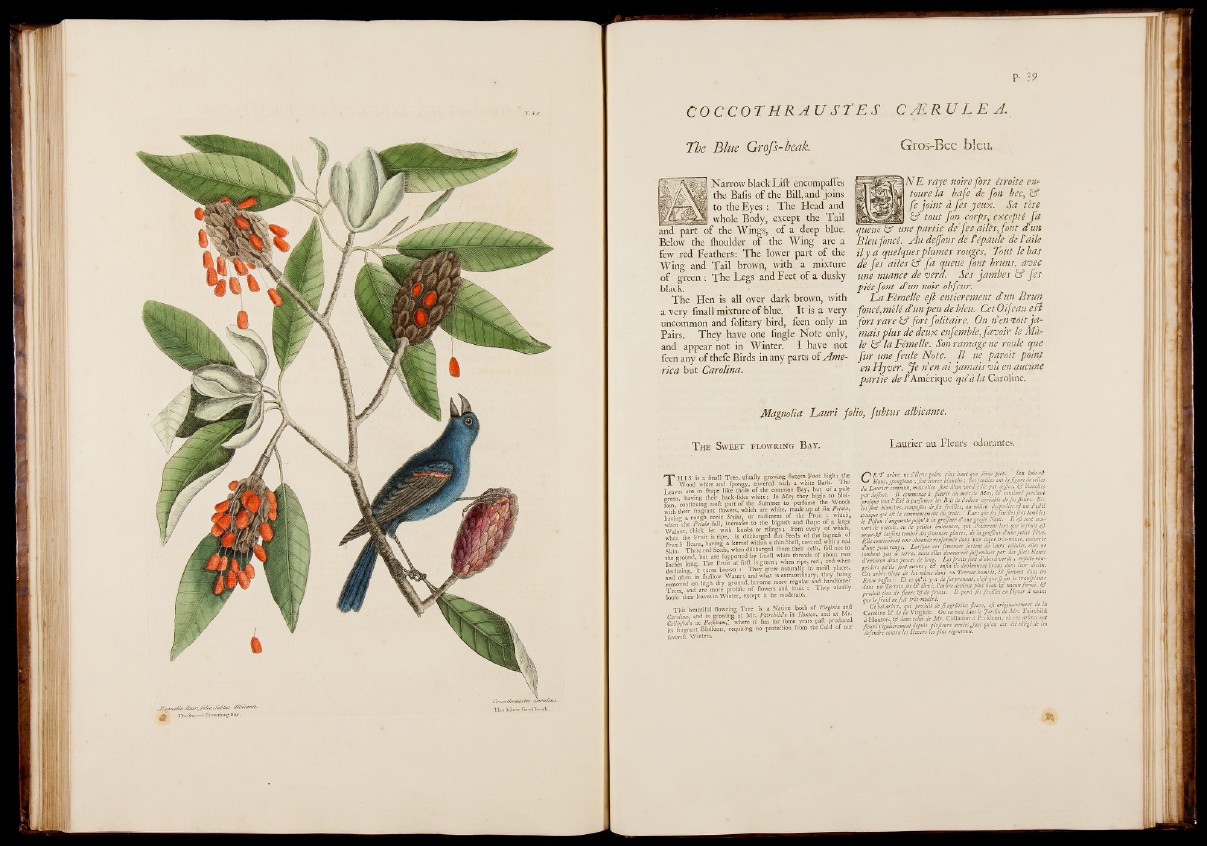
üüSHB
C O C C O T H R J U S T E S C Æ R U L E A.
The Blue Grofs-bcak. Gros-Bec bleu.
Narrow black Lift enoempaftes
the Baiis of the Bill, and joins
to the Eyes : The Head and
whole Body, except the Tail
part of. the Win gs,of a deep blue.
Below the flioulder. of the Wing are a
few red Heathers: Thé lower part of the
Wing and Tail brown, with , a mixture
of green : The Legs and Feet of a dusky
black. - ' - •
The Hen is all over dark brown, with
a very fmall mixture of blue, ' It is a Very,
uncommon and folitary bird, feén only in
Pairs. They have one Jingle Note only,
and appear not in Winter. I have not
feen any o f thefe Birds in any parts oi America
but Carolina,
N E ràfe noire fort étroite en>
toure la bafe de fon bec, y
J e joint à fes jeux. Sa tête
y tout fon corps, jxçepté fa
une partie de Jes dues, font d un
Bleu fortef Au deffoüs dé l'epaute de F aile
il y a quelques plumes rouies. Tout le bas
de fes ailes y fa quetlpfont bruns, avec
une nuance de vera. Ses jambes y fes
piés font d’un noir obfcur.
L a Femelle eft entièrement d’un Brun
foncé, mêlé d’un peu de bléu. Cet Oijeau eft
fort rare y fort folitaire. On rien Voit ja mais
plus de deux. enfemble,favoir le Mâle
y la Femelle. Son ramage ne roule que
fu r une feule Note. I l ne pqroit poinf
en Hyver. J e n’en ai jam aif yû en aucune
partie de /’Amérique qu’à la Caroline.
Magnolia Lauri folio, fubtus albicante. ~
T he S w e e t ' F l o w r i n g Bay. Laurier au Fleurs .odorantes,
TH I S is a:;fma1l Tree, ulnkAy- grassing-fmesn Foot h’ighV-tbc
Wood white and fpongy, covered with a white Bark. The
Leaves are in fhape like thofe of the common Bay, but of a pale
green, having their back-fides white: In May they begin to blof-
Fom, continuing moft part of the Summer to perfume the Woods
with their fragrant flowers, which are white, made up of fix Petala,
having a rough conic Stylus, or rudiment of the Fruit : which,
when the Petala fall, increafes to the bignefs and ihape of. a large
Walnut, thick fet with knobs or rifings ; from every of which,
when the Fruit is ripe, is difcharged flat Seeds of the bignefs of
French Beans, having a kernel within a thin Shell, covered with a red
Skin Thefe red Seeds, when difcharged from their cells, fall not tq.
the ground, but are fupported by fmall white threads of about two
Inches long. The Fruit at firft is green ; when ripe, red and when
declining, it turns brown : They grow naturally in moift places,
and often in lhallow Water; and what is extraordinary,/they^being
removed on high dry ground, become more regular and handfomer
Trees and are more prolific of flowers and fruit : They ufually
loPfe their leaves in Winter, except it be moderate."
This beautiful flowring Tree is a Native both of Virginia and
Carolina, and is growing at Mr. Fairchild’s in Hoxton, and at Mr.
Collinfon’s at Peckbamf where it lias for. fome years palt produced
its fragrant Bloffoms, requiring no protection from the Cold of our
fevereft Winters*
C E T arbre ne s’élève guère plus hautique feize piés.' Son. bois-eft
blanc, Jpongieux ; foriéccorce blanche Ses ftailles ont la figure de celles'
■ du Laurier commun, mais elles font, d’un verd pale par dejftis., & blanches
par dejfous. Il commence à fleurir au mois de May , & continue pendant
prefque tout l’Eté à parfumer les Bois de l’odeur agréable de fes fleurs. Elles
font blanches, compofies defix feuilles, ait milieu dcjquellcs eft un Piflil
conique qui eft le commencement du fruit. ' Lars que fesfeuilles font tombées
le Piftoh s’augmente jufqu’ à la grojfeür d’une groJJe .Noix. Il eft tout couvert
de noeuds, ou de petites éminences,'qui -s’ouvrent lors que le fruit eft
meurfS laijfent tomber des femences plattes, de la grojfeür d’une petite Fève.
Elle contiennent une Amande renfermée dans une coque très-mince, couverte
d'une peau rouge. Lorfqùe ces femences fortent de leu/s cellules, elles ne
tombent pas à terre, mais elles demeurent fufpenduës par des 'filets blancs
d’environ deux pouces de long. Les fruits font d abord verds ; enfuiterouges
lors qu’ils font meurs ; Q enfin ils deviennent bruns dans leur déclin.
Cet arbre vient de lui-même dans un Terroir humide, 6? fouvent dans les
Eaux baffes Et ce qu’il y a de furprenant,c’efl que fi on letranfplanle
dans un Terrein fec & élevé, l’arbre devient plus beau & mieux formé, &■
produit plus de fleurs fs? de fruits. Il perd fes feuilles en Hyver à moins
que" lé frotd ne fait.très-modéré. \ , ,
Ce bel arbre, qui produit de Ji agréables fleurs, eft originairement de là
Caroline fc? de la Virginie. On en voit dans le Jardin de Mr. Fairehild
à Hoxton, & dans celui de Mr. Collinfon à Peckham, oh ces arbres ont
fleuri régulièrement depuis plufleurs années,fans qu’op ait été obligé de les
defendre contre les Hivers les plus rigoureux.